【分分钟内搭建一个带用户系统的博客程序(一)用户系统】asp.net core的Identity真香,EF真香!
不用不知道,一用香到爆。
老哥是个屌丝前端,但也想写点web应用耍一耍。之前弄过了NodeJs,也弄过JAVA,最近由于写游戏的原因用C#,索性上手一波asp.net core。
这篇博客记录的是,如何在分分钟内搭建一个博客程序。包括:
- 发博客
- 看博客
- 用户注册登录
- 用户权限设置。
其中用的就是微软提供的EntityFrame和Identity类库。简直他妈爽出翔。
1.快速生成一个项目
反正增删改查就那么回事儿,快速生成一个项目模板才是主要的。

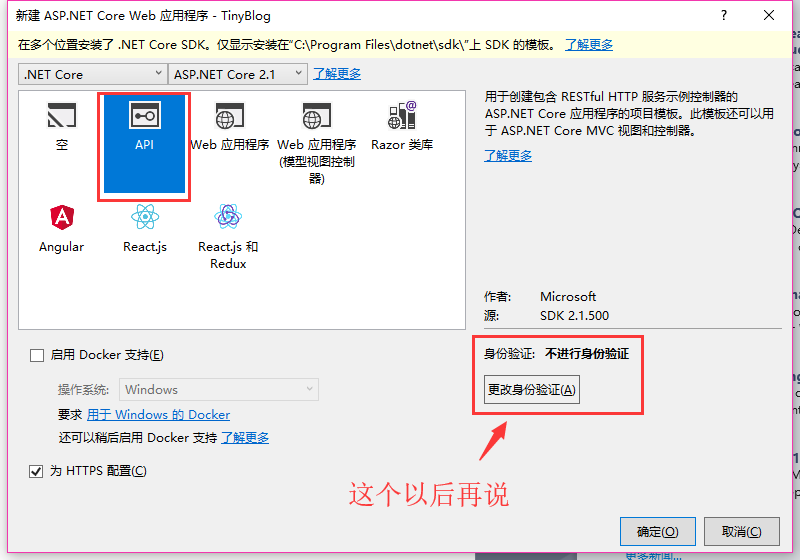
我不想创建一个带Razor页面的项目。因为我只需要API。老夫可是个前端!
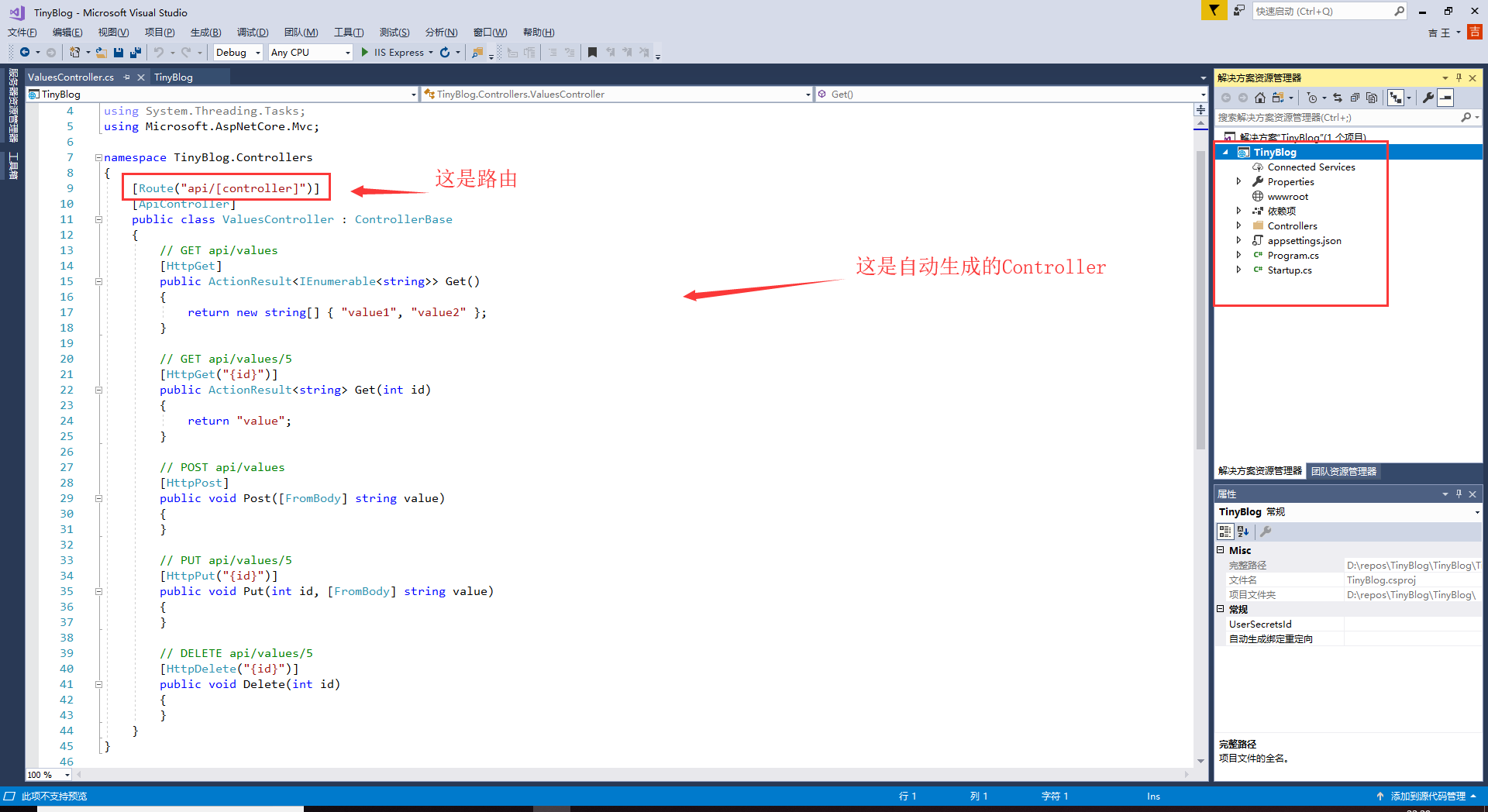
这个时候按F5运行网站,然后就可以用Postman向 http://localhost:55536/api/values发送请求了。如果有过开发经验的人一眼就能看明白这是怎么回事儿。
2.给程序添加用户系统。
添加用户系统的意思是,允许用户注册和登录。
如果我用NodeJs或者Java,我就要开始写数据库了,甚至设计数据表。可是微软已经把好用的东西给准备好了,那就是:Identity类库。这个类库老JB好了。我只需要轻轻点几下,一套完备的用户系统就能生成到我的代码上。



我现在来解释一波我进行了什么操作。
1.刚才我加的一大堆东西,其实就是最开始创建项目的时候,“身份验证”那一部分帮我们做的事。当时我没选,现在我手动加上。
2.上面这个图,“替代所有文件”这部分如果选中,框架会帮我们生成相应的业务逻辑和Html模板(当然是Razor模板)。
3.因为注册登录需要和数据库交互,所以“新建数据库上下文类”帮我们新生成了一个和数据库交互的上下文类。这个类是EntityFramework提供的。巨牛逼巨方便。
4.“新建用户类”,这没什么好说的吧?这个用户类用于和数据库的用户表进行对应。
这下我们牛逼了。然后你会发现项目目录里多了一些文件,这些都是asp.net core帮我们生成的。

可以随便探索一下。那个Readme.txt文件可以读一下。是一个指导手册,告诉你接下来要怎么做。
3.那么接下来要怎么做?
如readme文件所说,一步一步来。我还是贴出来readme文件:
- Support for ASP.NET Core Identity was added to your project
- - The code for adding Identity to your project was generated under Areas/Identity.
- Configuration of the Identity related services can be found in the Areas/Identity/IdentityHostingStartup.cs file.
- If your app was previously configured to use Identity, then you should remove the call to the AddIdentity method from your ConfigureServices method.
- //生成的UI需要静态文件支持,用下面这段代码使你的app支持静态文件
- The generated UI requires support for static files. To add static files to your app:
- . Call app.UseStaticFiles() from your Configure method
- //用下面这段代码开启身份认证功能
- To use ASP.NET Core Identity you also need to enable authentication. To authentication to your app:
- . Call app.UseAuthentication() from your Configure method (after static files)
- //生成的UI需要MVC支持,用这面这段代码开启MVC功能
- The generated UI requires MVC. To add MVC to your app:
- . Call services.AddMvc() from your ConfigureServices method
- . Call app.UseMvc() from your Configure method (after authentication)
- //生成的数据库结构需要你执行Migration来同步数据库
- The generated database code requires Entity Framework Core Migrations. Run the following commands:
//在cmd中执行下面两个命令- . dotnet ef migrations add CreateIdentitySchema
- . dotnet ef database update
//或者 在包管理命令行执行下面两个命令- Or from the Visual Studio Package Manager Console:
- . Add-Migration CreateIdentitySchema
- . Update-Database
- Apps that use ASP.NET Core Identity should also use HTTPS. To enable HTTPS see https://go.microsoft.com/fwlink/?linkid=848054.
按照上面的操作来撸好app以后。框架就搭成了。牛逼到爆。一行代码都没写,一个非常完备的基础架子已经OK了。
需要注意的是,你要额外安装EntityFramework类库。这个百度教程太多了。我就不说了。
当你执行完那两个命令后,你会发现你的数据库里多了一些表。酷!成功了。
注:在这里执行命令的时候可能会说EntityFramework没安装什么的这时候不要虚,仔细看输出,会说你装了EF6和EFCore,你要指定一下用哪个EF来运行命令,asp.net core的话就用 EntityFrameworkCore\Update-Database
4.写一波注册用户的API吧!
其实注册的业务逻辑已经生成好了,直接拿来用就可以。去Areas/Identity/Pages/Account/Register.cshtml里面,可以看到这段代码。稍微改动一下就可以拿来用了。
首先是,我打算用Postman模拟用户前端的输入,后端在注册的时候接收3个值,邮箱,用户名,密码。于是俺创建一个类代表这个数据格式。强类型语言就是爽。
- public class UserRegisterInput
- {
- public string UserName { get; set; }
- public string Email { get; set; }
- public string Password { get; set; }
- public bool RememberMe { get; set; }
- }
现在开始写controller。新建一个APIController,这个简直不用再描述了。最后Controller代码如下:
- using System;
- using System.Collections.Generic;
- using System.Linq;
- using System.Threading.Tasks;
- using Microsoft.AspNetCore.Http;
- using Microsoft.AspNetCore.Identity;
- using Microsoft.AspNetCore.Mvc;
- using TinyBlog2.Areas.Identity.Data;
- using TinyBlog2.DTO;
- namespace TinyBlog2.Controllers
- {
- [Route("api/[controller]")]
- [ApiController]
- public class UserController : ControllerBase
- {
- private readonly UserManager<TinyBlog2User> _userManager;
- public UserController(UserManager<TinyBlog2User> userManager)
- {
- _userManager = userManager;
- }
- [HttpPost]
- [Route("Reg")] //这里是你的路由地址 post发往 https://localhost:55683/api/user/reg
- public async Task<IActionResult> Post([FromBody] UserRegisterInput Input)
- {
- var user = new TinyBlog2User { UserName = Input.UserName, Email = Input.Email };
- var result = await _userManager.CreateAsync(user, Input.Password);
- if (result.Succeeded)
- {
- return Ok("注册成功");
- }
- else
- {
- return BadRequest();
- }
- }
- [HttpGet]
- public ActionResult<IEnumerable<string>> Get()
- {
- return new string[] { "value1", "value2" };
- }
- }
- }
然后我用Postman发一波请求试试。

注册的最后,查看数据库,你的用户显然已经存在数据库里了。这些数据表都是asp.net core + EntityFramework给我们建立好的。
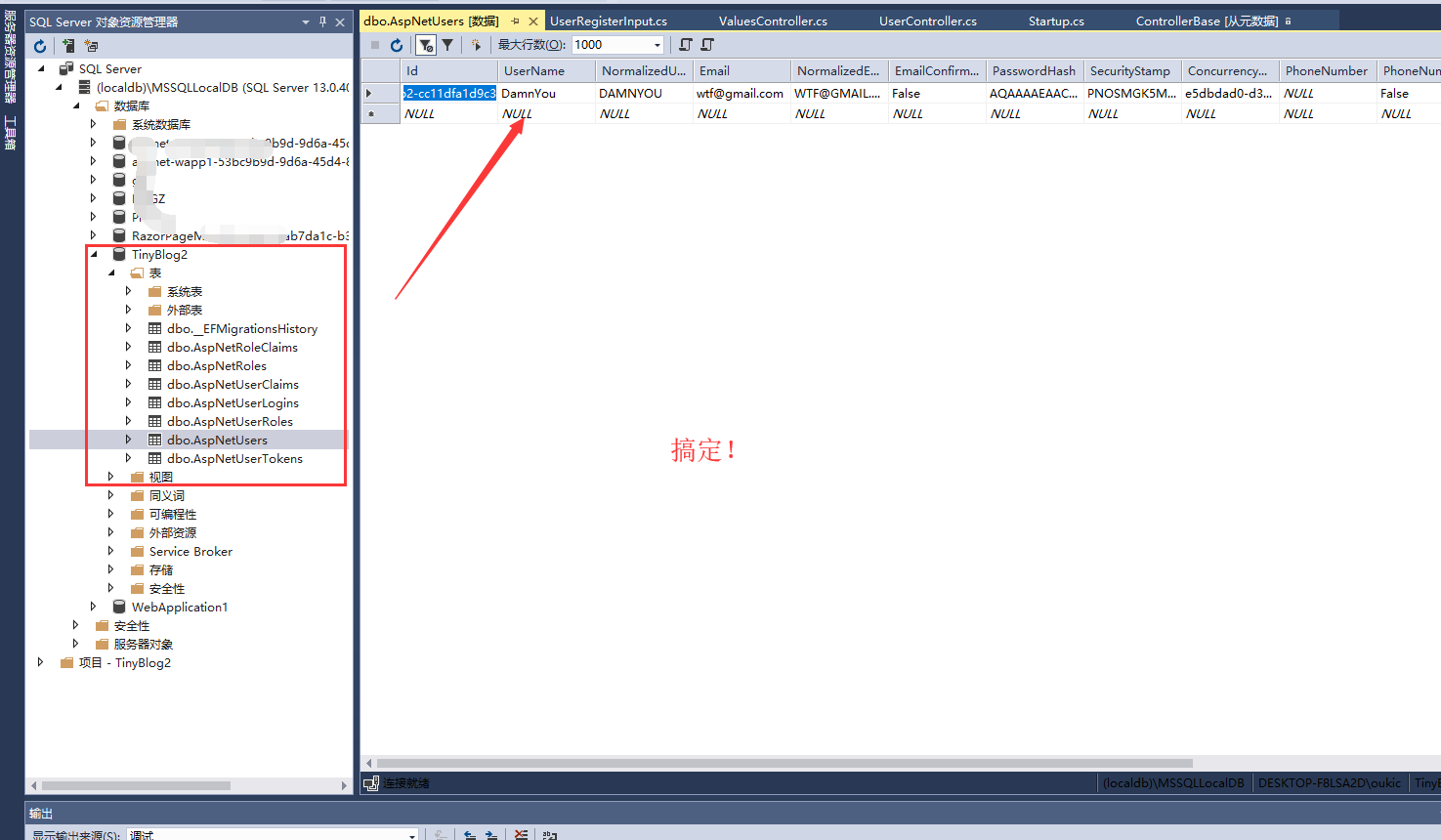
5.用户权限校验
接下来我要做的是,给某个Action增加权限校验,说句白话就是,有的接口我希望登录用户才能访问,有的接口我希望管理员才能访问,或者有的接口我希望只有付费Vip才能访问。怎么做呢?
这里用已经存在的ViewController来举例子。目前为止,ValueController的数据是谁都可以访问的。但是我来加一行代码,就一行!
- [HttpGet]
- [Authorize(Policy = "VipOnly")]//很明显,从此这个Action只能是Vip才能访问。
- public ActionResult<IEnumerable<string>> Get()
- {
- return new string[] { "value1", "value2" };
- }
显然我定制了一个策略,这个策略名字叫做VipOnly。那么接下来我要定义这个策略。
- public void ConfigureServices(IServiceCollection services)
- {
- services.AddAuthorization(options =>
- {
- options.AddPolicy("VipOnly", policy => policy.RequireClaim("Role", "VipUser"));
- });
- services.AddMvc().SetCompatibilityVersion(CompatibilityVersion.Version_2_1);
- }
我在startup.cs里面加入这一行代码,应该显而易见。意思是:增加一个名为VipOnly的策略,这个策略的要求是,如果用户有一个属性Role,这个Role的值是VipUser,那么就符合这个策略。
Claim就是用户的一个属性。这个属性可以在任何时候创建。这个Claim也是Asp.net core提供给我们的工具!很方便。来看一波代码吧。
5.1 如何给用户添加一个Claim
我更改了一下注册流程,每一个注册用户都被默认设置为VipUser
- [HttpPost]
- [Route("Reg")]
- public async Task<IActionResult> Post([FromBody] UserRegisterInput Input)
- {
- var user = new TinyBlog2User { UserName = Input.UserName, Email = Input.Email };
- var result = await _userManager.CreateAsync(user, Input.Password);
- //给用户增加一个Claim
- var addClaimResult = await _userManager.AddClaimAsync(user, new System.Security.Claims.Claim("Role", "VipUser"));
- if (result.Succeeded)
- {
- return Ok("注册成功");
- }
- else
- {
- return BadRequest();
- }
- }
简单到爆炸不是吗?我现在注册一个用户,就会看到这个用户被添加了一个Claim,Role=VipUser
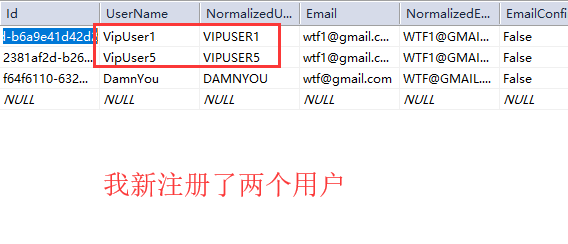
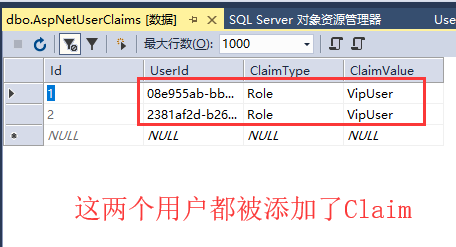
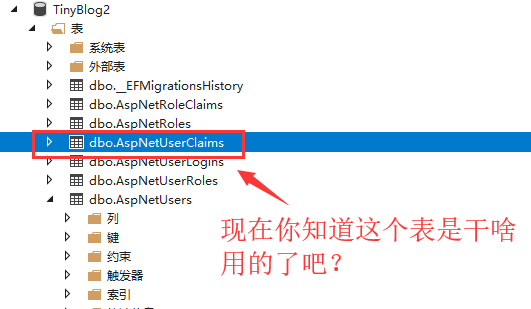
6.用户登录
用户登录的原理是JWT。是一个独立知识点。这里我只提供代码。教程网上一堆。需要我写的话请留言,我再补充。
- using System;
- using System.Collections.Generic;
- using System.IdentityModel.Tokens.Jwt;
- using System.Linq;
- using System.Security.Claims;
- using System.Text;
- using System.Threading.Tasks;
- using Microsoft.AspNetCore.Http;
- using Microsoft.AspNetCore.Identity;
- using Microsoft.AspNetCore.Mvc;
- using Microsoft.Extensions.Configuration;
- using Microsoft.IdentityModel.Tokens;
- using TinyBlog2.Areas.Identity.Data;
- using TinyBlog2.DTO;
- namespace TinyBlog2.Controllers
- {
- [Route("api/[controller]")]
- [ApiController]
- public class UserController : ControllerBase
- {
- private readonly UserManager<TinyBlog2User> _userManager;
- private readonly IConfiguration _config;
- private readonly SignInManager<TinyBlog2User> _signInManager;
- public UserController(UserManager<TinyBlog2User> userManager, IConfiguration configuration, SignInManager<TinyBlog2User> signInManager)
- {
- _config = configuration;
- _signInManager = signInManager;
- _userManager = userManager;
- }
- [HttpPost]
- [Route("Reg")]
- public async Task<IActionResult> Post([FromBody] UserRegisterInput Input)
- {
- var user = new TinyBlog2User { UserName = Input.UserName, Email = Input.Email };
- var result = await _userManager.CreateAsync(user, Input.Password);
- //给用户增加一个Claim
- var addClaimResult = await _userManager.AddClaimAsync(user, new System.Security.Claims.Claim("Role", "VipUser"));
- if (result.Succeeded && addClaimResult.Succeeded)
- {
- var key = new SymmetricSecurityKey(Encoding.UTF8.GetBytes(_config["Jwt:Key"]));
- //将加密后的密码用JWT指定算法进行加密
- var creds = new SigningCredentials(key, SecurityAlgorithms.HmacSha256);
- //拿到当前登录用户
- TinyBlog2User currentUser = await _userManager.FindByEmailAsync(Input.Email);
- //获取当前用户的Claims
- IList<Claim> claimsList = await _userManager.GetClaimsAsync(currentUser);
- var unSecruityToken = new JwtSecurityToken(_config["Jwt:Issuer"], _config["Jwt:Issuer"], claimsList, expires: DateTime.Now.AddMinutes(), signingCredentials: creds);
- var token = new JwtSecurityTokenHandler().WriteToken(unSecruityToken);
- return Ok(new { user = user, token = token });
- }
- else
- {
- return BadRequest();
- }
- }
- /// <summary>
- /// 前后端分离,前端的登录请求发送到这里。
- /// 返回200或者401,代表登录成功和失败,如果登录成功,返回一个token。
- /// </summary>
- /// <param name="inputUser"></param>
- /// <returns>
- /// {"token": "eyJhbGciOiJIUzI1NiIsInR5cCI6IkpXVCJ9.eyJlbWFpbCI6IjFAMS5jb20iLCJqdGkiOiI0ZDNiZGFjMC1hNjYzLTQwNTMtYjU1Yy02Njg2YjAyNjk0MmIiLCJFbWFpbCI6IjFAMS5jb20iLCJleHAiOjE1NDQxODgwMDcsImlzcyI6Imh0dHA6Ly9sb2NhbGhvc3Q6NjM5MzkvIiwiYXVkIjoiaHR0cDovL2xvY2FsaG9zdDo2MzkzOS8ifQ.GTFmUKiAfLTaOuv7rZ-g4Cns033RWehB8u3iFB59rFM"}
- /// </returns>
- [HttpPost]
- [Route("Login")]
- public async Task<IActionResult> Login([FromBody]UserLoginInput inputUser)
- {
- //拿到用户名和密码,用asp.net Core 自带的Identity来进行登录
- var result = await _signInManager.PasswordSignInAsync(inputUser.UserName, inputUser.Password, inputUser.RememberMe, lockoutOnFailure: true);
- if (result.Succeeded)
- {
- //把你自己的密码进行对称加密
- var key = new SymmetricSecurityKey(Encoding.UTF8.GetBytes(_config["Jwt:Key"]));
- //将加密后的密码用JWT指定算法进行加密,这个加密算法有很多,可以去JWT官网上看
- var creds = new SigningCredentials(key, SecurityAlgorithms.HmacSha256);
- //拿到当前登录用户
- TinyBlog2User user = await _userManager.FindByEmailAsync(inputUser.Email);
- //获取当前用户的Claims
- IList<Claim> claimsList = await _userManager.GetClaimsAsync(user);
- //用各种信息组成一个JWT
- var unSecruityToken = new JwtSecurityToken(_config["Jwt:Issuer"], _config["Jwt:Issuer"], claimsList, expires: DateTime.Now.AddMinutes(), signingCredentials: creds);
- //把JWT加密一下返回给客户端
- var token = new JwtSecurityTokenHandler().WriteToken(unSecruityToken);
- return Ok(new { token = token });
- }
- else
- {
- return Unauthorized();
- }
- }
- [HttpGet]
- public ActionResult<IEnumerable<string>> Get()
- {
- return new string[] { "value1", "value2" };
- }
- }
- }
UserController.cs
- using System;
- using System.Collections.Generic;
- using System.Linq;
- using System.Text;
- using System.Threading.Tasks;
- using Microsoft.AspNetCore.Authentication.JwtBearer;
- using Microsoft.AspNetCore.Builder;
- using Microsoft.AspNetCore.Hosting;
- using Microsoft.AspNetCore.HttpsPolicy;
- using Microsoft.AspNetCore.Mvc;
- using Microsoft.Extensions.Configuration;
- using Microsoft.Extensions.DependencyInjection;
- using Microsoft.Extensions.Logging;
- using Microsoft.Extensions.Options;
- using Microsoft.IdentityModel.Tokens;
- namespace TinyBlog2
- {
- public class Startup
- {
- public Startup(IConfiguration configuration)
- {
- Configuration = configuration;
- }
- public IConfiguration Configuration { get; }
- // This method gets called by the runtime. Use this method to add services to the container.
- public void ConfigureServices(IServiceCollection services)
- {
- services.AddAuthentication(JwtBearerDefaults.AuthenticationScheme)
- .AddJwtBearer(options =>
- {
- options.TokenValidationParameters = new TokenValidationParameters
- {
- ValidateIssuer = true,
- ValidateAudience = true,
- ValidateLifetime = true,
- ValidateIssuerSigningKey = true,
- ValidIssuer = Configuration["Jwt:Issuer"],
- ValidAudience = Configuration["Jwt:Issuer"],
- IssuerSigningKey = new SymmetricSecurityKey(Encoding.UTF8.GetBytes(Configuration["Jwt:Key"]))
- };
- });
- services.AddAuthorization(options =>
- {
- options.AddPolicy("VipOnly", policy => policy.RequireClaim("Role", "VipUser"));
- });
- services.AddMvc().SetCompatibilityVersion(CompatibilityVersion.Version_2_1);
- }
- // This method gets called by the runtime. Use this method to configure the HTTP request pipeline.
- public void Configure(IApplicationBuilder app, IHostingEnvironment env)
- {
- if (env.IsDevelopment())
- {
- app.UseDeveloperExceptionPage();
- }
- else
- {
- app.UseHsts();
- }
- app.UseStaticFiles();
- app.UseAuthentication();
- app.UseHttpsRedirection();
- app.UseMvc();
- }
- }
- }
Startup.cs
现在用户登录以后就会得到一串JWT。以后每次发请求的时候在头部附带JWT,浏览器就会认出用户的身份,并且方便的做权限验证了。这里附上PostMan设置。美滋滋。
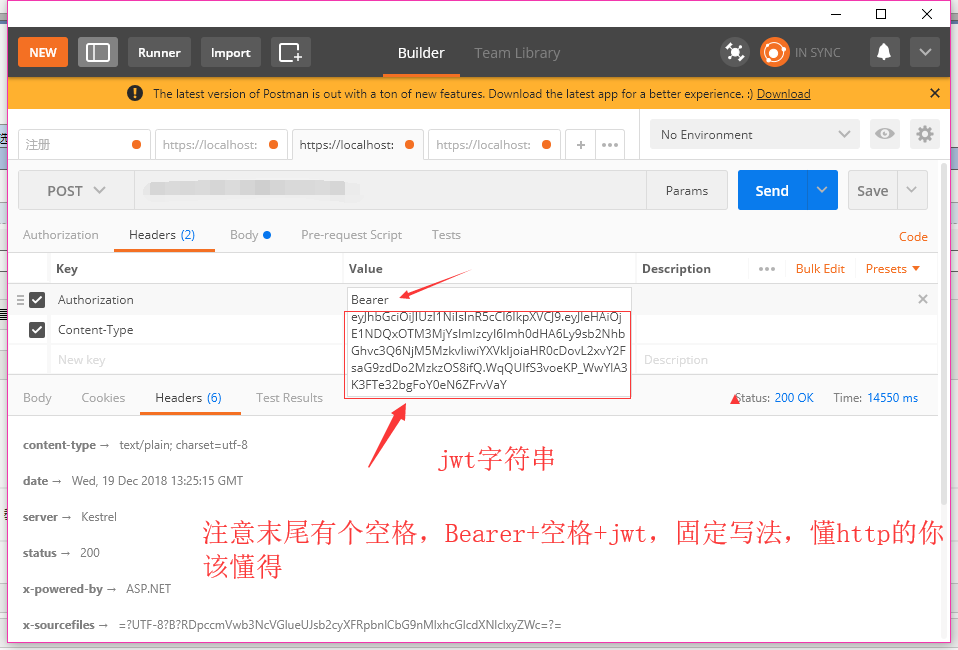
7.试验一波

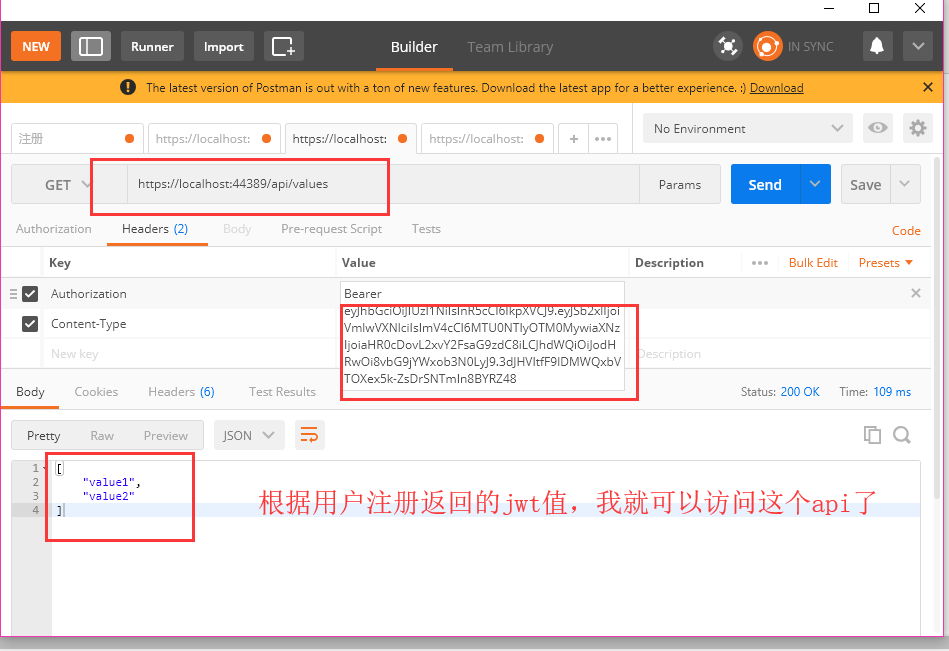
8.搞定和额外说明
- 用户注册默认是依靠UserName来注册的。
其实用户系统才是最大的门槛。至于帖子的增删改查。可以用很简单的一篇博客就能搞定了。祝你开心。
【分分钟内搭建一个带用户系统的博客程序(一)用户系统】asp.net core的Identity真香,EF真香!的更多相关文章
- 怎样搭建一个自有域名的 WORDPRESS 博客?
博客搭建并不复杂,只是过程有点繁琐,适合喜欢折腾的人,主要有下面几个步骤: 新建一个博客文件 购买域名(Domain Name) 注册一个主机空间(Web Host) 域名解析(DNSPod) 安装W ...
- 技术人如何利用 github+Jekyll ,搭建一个独立免费的技术博客
上次有人留言说,技术博客是程序员的标配,但据我所知绝大部分技术同学到现在仍然没有自己的技术博客.原因有很多,有的是懒的写,有的是怕写不好,还有的是一直想憋个大招,幻想做到完美再发出来,结果一直胎死腹中 ...
- 用 node.js 的 hexo 框架搭建一个支持 markdown 的静态博客系统
1,Hexo如何在线可视化写博客: 可以试试这款插件 hexo-admin. 2,马克飞象: 一个非常好的 markdown 编辑器. 3,Hexo博客文章设置密码的方法: 首先,在Hexo中 ...
- 在Github上面搭建一个自己域名的Hexo博客
前言 在一次看到别人的博客主页,觉得设计很漂亮.但是由于自己对于前台这块没什么办法,煞是羡慕.偶然中发现这种样式是在Github上面搭建的,使用的是Next主题.于是便想自己也搭建一个,于是便去就去查 ...
- 从零开始,搭建博客系统MVC5+EF6搭建框架(5),博客详情页、留言、轮播图管理、右侧统计博文
一.博客系统进度回顾 上一遍博客介绍到,系统已经实现到了发布以及前台布局展示,接下来就是实现一些,详情页,留言.轮播图管理.右侧博文统计信息实现. 二.博客系统详情页实现 2.1先来看看详情页展示的效 ...
- 一个基于 Beego 的,能快速创建个人博客,cms 的系统
学习beego时候开发的一个博客系统,在持续完善,有不足之处,望大佬们多多体谅,并且指出.感谢! Go Blog 一个基于Beego的,能快速创建个人博客,cms 的系统 包含功能 查看 Go Blo ...
- 一个 "开箱即用" 个人博客全栈系统项目!vue+node+express+mysql+sequlize+uniapp
" MG'Blog " 一个 "开箱即用" 个人博客全栈系统项目! 探索本项目的源码 » 前台预览 · 管理端预览 v1.0.2 小程序预览 v1.0.2 介绍 ...
- 使用Jekyll搭建免费的Github Pages个人博客
一.Git 1.Git概述 Git is a free and open source distributed version control system designed to handle ev ...
- Java语言课程设计——博客作业教学数据分析系统(201521123107 张翔)
#Java语言课程设计--博客作业教学数据分析系统(个人博客) 1.团队课程设计博客链接 [博客作业教学数据分析系统(From:网络五条狗)](http://www.cnblogs.com/fanta ...
随机推荐
- nodejs连接mongodb
一.安装 a.访问mongodb官网下载https://www.mongodb.com/,有zip或者msi版本,zip解压缩就可以用,msi需要安装后使用 b.安装,指定好安装路径,一路下一步 c. ...
- 配置myslq提示 the configuration step starting server is taking longer than expected we apologize for thi
.卸载重新安装,勾选日志配置选项,自定义日志输出路径
- OpenCL 三种内存对象的使用
▶ 包括带有 CL_MEM_READ_ONLY,CL_MEM_WRITE_ONLY,CL_MEM_READ_WRITE 标识的显示拷贝(函数 clEnqueueWriteBuffer 和 clEnqu ...
- Git---远程仓库之从远程仓库克隆03
远程仓库之添加远程仓库02我们讲了先有本地库,后有远程库,如何关联远程库. 现在假设我们从零开发,那么最好的方式是先创建远程库,然后,从远程库克隆. 首先,登录GitHub,创建一个新的仓库,名字叫g ...
- Git--时光穿梭机之删除文件06
在Git中,删除也是一个修改操作,我们实际操作一下吧,先添加一个文件test.txt到Git并且提交 $ git add test.txt $ git commit -m "add test ...
- 行为型-命令模式(Command)
装修新房的最后几道工序之一是安装插座和开关,通过开关可以控制一些电器的打开和关闭,例如电灯或者排气扇.在购买开关时,我们并不知道它将来到底用于控制什么电器,也就是说,开关与电灯.排气扇并无直接关系,一 ...
- 【321】python进程监控:psutil
参考:Python进程监控-MyProcMonitor 参考:Python3.6 安装psutil 模块和功能简介 参考:psutil module (Download files) 参考:廖雪峰 - ...
- 为Eclipse安装功能扩展插件
---------siwuxie095 关于 Eclipse 的下载.安装与配置,详见本人博客分类:利剑出鞘, 里面的 Eclipse的配置 本人博客( ...
- ubuntu账户密码正确但是登录不进去系统
ubuntu12.04管理员账户登录不了桌面,只能客人会话登录 求助!!ubuntu12.04管理员账户登录不了桌面,只能客人会话登录. ctrl+alt+f1 ,切换到tty1,输入管理员帐号和密码 ...
- Java初学者不得不知的概念,JDK,JRE,JVM的区别?(转)
JVM(Java Virtual Machine Java虚拟机)可以理解为是一个虚拟出来的计算机,具备着计算机的基本运算方式,它主要负责将java程序生成的字节码文件解释成具体系统平台上的机器指令. ...
